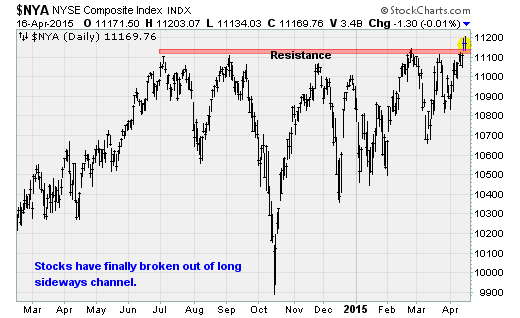What is pushing stocks into a new uptrend?
Investors have suffered through a lot in recent months. From the Ebola scare in October to the oil-related meltdown in December, as well as fears over a slowdown in global economic data, trepidation surrounding the specter of interest rate hikes in the U.S., and the still unresolved bailout negotiations between Greece and the European establishment.
No surprise then that the NYSE Composite Index -- a broad measure of the U.S. stock market -- has been mired in a long, churning trading range going back to July.
Until this week.
The index blasted up and over technical resistance on Wednesday and consolidated the move on Thursday, setting the stage for a new medium-term uptrend. The catalyst: Indications from Fed officials that they are likely to postpone rate liftoff until later this year or even early 2016.
To be sure, there are still many moving parts for investors to focus on. The first-quarter earnings season is heating up. The latest macroeconomic data remains uneven, with housing starts disappointing in March, for example, but the single-family component strengthening. And the situation in Greece is back on the front page as it looks like Athens could miss its International Monetary Fund debt payments in May, setting the stage for a showdown between the newly elected leftist government and the eurozone's biggest economies.
Yet a turnaround in the flow of commentary has reignited animal spirits in a way that hasn't been seen in nearly a year. The bulls are in control with breadth measures improving, option activity swinging back to calls and the CBOE Volatility Index (VIX), or "fear gauge," dropping hard and fast. The dollar has been falling in sympathy on expectations of a continuation of ultra-low interest rates, which in turn is boosting commodity prices, especially crude oil.
Federal Reserve Vice Chair Stanley Fischer was on center stage Thursday as he noted that economic demand is pretty weak and that inflation will rise toward the central bank's two percent target only over the next couple of years. That suggests the Fed could be forced to take it slow on rate hikes for quite some time.
Separately, Boston Fed president Eric Rosengren believes the unemployment rate will need to fall all the way down to 5 percent, from 5.5 percent now, before the nation reaches full employment and worker wages start to grow in earnest. That's something officials believe may not happen until as late as 2017 or longer based on their most recent estimates.
Atlanta Fed president Dennis Lockhart believes recent disappointment in the economic data should forestall any rate hikes until the economic picture is clearer.
And finally, St. Louis Fed president James Bullard, considered a hawk on monetary policy, said this week that the Fed isn't going to try to surprise markets with a sooner-than-expected rate hike and that should rate liftoff damage growth, the Fed will quickly bring rates back down again in response.
The next Fed policy announcement on April 29 is likely to dwell on the poor March payroll report, likely taking a June rate hike off the table. The futures market isn't looking for a move on rates until the fourth quarter with policy announcements in October and December.
That clears the way for stock bulls to run prices higher throughout the summer and join the party that's been underway in bourses across Asia and Europe this year.

